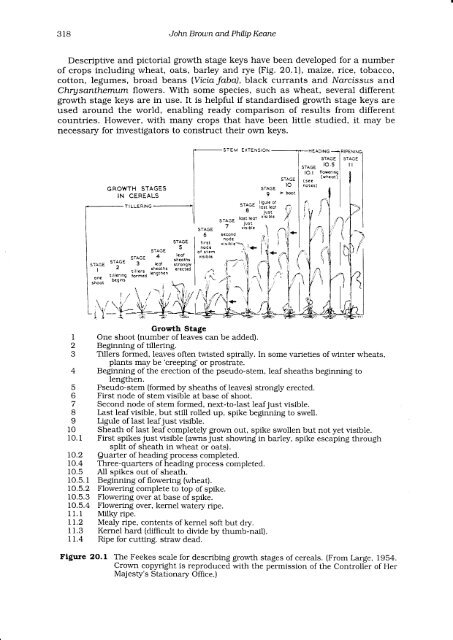Assessment of disease and effects on yield - Australasian Plant ...
Assessment of disease and effects on yield - Australasian Plant ...
Assessment of disease and effects on yield - Australasian Plant ...
You also want an ePaper? Increase the reach of your titles
YUMPU automatically turns print PDFs into web optimized ePapers that Google loves.
318 John Brotun a nd Philto Keane<br />
Descriptive <str<strong>on</strong>g>and</str<strong>on</strong>g> pictorial growth stage keys have been developed for a number<br />
<str<strong>on</strong>g>of</str<strong>on</strong>g> crops including wheat, oats, barley <str<strong>on</strong>g>and</str<strong>on</strong>g> rye (Fig. 20.1), rnaize, rice, tobacco,<br />
cott<strong>on</strong>, legumes, broad beans (Vicia Jaba), black currants <str<strong>on</strong>g>and</str<strong>on</strong>g> lVarcissus <str<strong>on</strong>g>and</str<strong>on</strong>g><br />
Chrysanthemum flowers. With some species, such as wheat, several different<br />
growth stage keys are in use. It is helpful if st<str<strong>on</strong>g>and</str<strong>on</strong>g>ardised growth stage keys are<br />
used around the world, enabling ready comparis<strong>on</strong> <str<strong>on</strong>g>of</str<strong>on</strong>g> results from different<br />
countries. However, with many crops that have been little studied, it may be<br />
necessary for investigators to c<strong>on</strong>struct their own keys.<br />
GROWTH STAGES<br />
IN CEREALS<br />
STEM EXTENSION<br />
STAGE<br />
7<br />
sac<strong>on</strong>d<br />
nodc<br />
visiblc<br />
ligulc ot<br />
STAGElost<br />
lcsl<br />
n<br />
lqst lcoi<br />
JUst<br />
vi sr bl?<br />
Grovth Stage<br />
1 One shoot (number <str<strong>on</strong>g>of</str<strong>on</strong>g> leaves can be added).<br />
2 Beginning <str<strong>on</strong>g>of</str<strong>on</strong>g> tillering.<br />
3 Tillers formed, leaves <str<strong>on</strong>g>of</str<strong>on</strong>g>ten twisted spirally. In some varieties <str<strong>on</strong>g>of</str<strong>on</strong>g> winter wheats,<br />
plants may be 'creeping' or prostrate.<br />
4 Beginning <str<strong>on</strong>g>of</str<strong>on</strong>g> the erecti<strong>on</strong> <str<strong>on</strong>g>of</str<strong>on</strong>g> the pseudo-stem, leaf sheaths beginning to<br />
lengthen.<br />
5 Pseudo-stem (formed by sheaths <str<strong>on</strong>g>of</str<strong>on</strong>g> leaves) str<strong>on</strong>gly erected.<br />
6 First node <str<strong>on</strong>g>of</str<strong>on</strong>g> stem visible at base <str<strong>on</strong>g>of</str<strong>on</strong>g> shoot.<br />
7 Sec<strong>on</strong>d node <str<strong>on</strong>g>of</str<strong>on</strong>g> stem formed, nexl-to-last leaf just visible.<br />
8 t ast leaf visible, but still rolled up, spike beginning to swell.<br />
9 Ligule <str<strong>on</strong>g>of</str<strong>on</strong>g> last leaf just visible.<br />
I0 Sheath <str<strong>on</strong>g>of</str<strong>on</strong>g> last leaf completely grown out, spike swollen but not yet visible.<br />
10. 1 First spikes just visible (awns just showing in barley, spike escaping through<br />
split <str<strong>on</strong>g>of</str<strong>on</strong>g> sheath in wheat or oats).<br />
IO.2 Quarter <str<strong>on</strong>g>of</str<strong>on</strong>g> heading process completed.<br />
10.4 Three-quarters <str<strong>on</strong>g>of</str<strong>on</strong>g> heading process completed.<br />
10.5 All spikes out <str<strong>on</strong>g>of</str<strong>on</strong>g> sheath.<br />
10.5.1 Beginning <str<strong>on</strong>g>of</str<strong>on</strong>g> flowering (wheat).<br />
f 0.5.2 Flowering complete to top <str<strong>on</strong>g>of</str<strong>on</strong>g> spike.<br />
10.5.3 Flowering over at base <str<strong>on</strong>g>of</str<strong>on</strong>g> spike.<br />
10.5.4 Flowering over, kernel watery ripe.<br />
l1.l Millcy ripe.<br />
ll.2 Mealy ripe, c<strong>on</strong>tents <str<strong>on</strong>g>of</str<strong>on</strong>g> kernel s<str<strong>on</strong>g>of</str<strong>on</strong>g>t but dry.<br />
f 1.3 Kernel hard (difficult to divide by thumb-nail).<br />
11.4 Ripe for cutting. straw dead.<br />
Figure 2O.1 The Feekes scale for describing growth stages <str<strong>on</strong>g>of</str<strong>on</strong>g> cereals. (From Large, 1954.<br />
Crown copyright is reproduced with the permissi<strong>on</strong> <str<strong>on</strong>g>of</str<strong>on</strong>g> the C<strong>on</strong>troller <str<strong>on</strong>g>of</str<strong>on</strong>g> Her<br />
Maj esty's Stati<strong>on</strong>ary Office. )<br />
\r+<br />
STAGE<br />
9<br />
ju:!<br />
vtstDtc<br />
\<br />
I<br />
rl






![[Compatibility Mode].pdf](https://img.yumpu.com/27318716/1/190x135/compatibility-modepdf.jpg?quality=85)










